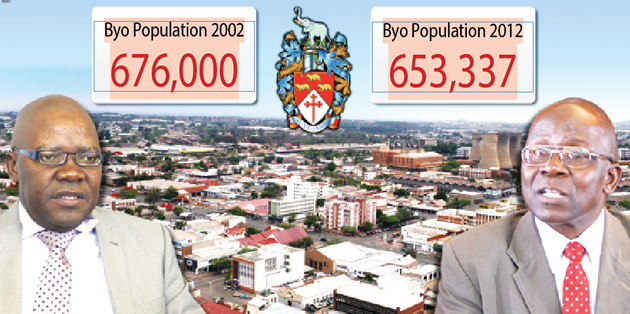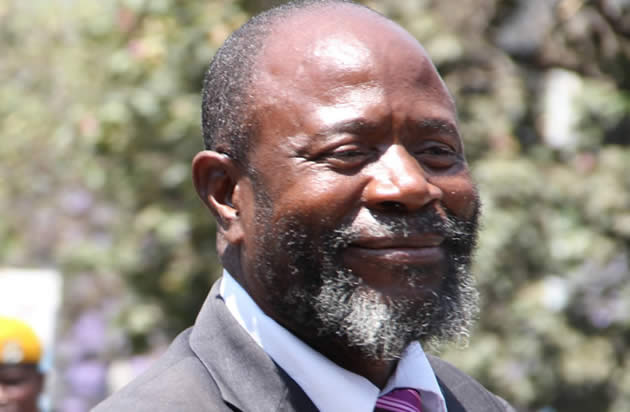Census findings spark outrage…Mayor claims anti-Bulawayo conspiracy


Bulawayo Mayor Clr Martin Moyo (right) has disputed findings of the 2012 census overseen by the Ministry of Finance that fell under the MDC-T’s Tendai Biti (left)
Pamela Shumba Senior Reporter—
THE Bulawayo City Council has accused the Zimbabwe National Statistical Agency (ZimStat) of deliberately understating the number of people living in the city in a calculated ploy to ensure that central government underfunds the municipality. According to results of the August 2012 population census released by ZimStat, Bulawayo’s population stands at 653,337 down from the official 676,000 that came out of the 2002 enumeration exercise.
The census, which put Harare’s population at 2,123,132, was conducted during the inclusive government era and was overseen by the then Ministry of Finance that fell under Tendai Biti.
Of all the country’s 10 provinces, Bulawayo had the least number of people, while Harare was said to have the highest number of inhabitants.
Bulawayo Mayor Councillor Martin Moyo said he had “reservartions” about the 653,337 figure given by ZimStat.
“We’ve a rough idea that Bulawayo has slightly more than a million people, based on the housing units that we’ve and an average number of six people inhabiting the houses. We’ve reservations because we feel that the figures could have been more,” said Clr Moyo.
He added that the figure had a negative bearing on the city because when it comes to resource allocation, areas with more people get a higher allocation from central government.
There were also concerns that the population decline could impact negatively on investment prospects.
“When it comes to allocations of resources by the government, wrong figures have a negative impact on how much is disbursed to us. I’m not an expert, but I was once an enumerator and I noticed that the recent census was not as thorough as the previous censuses,” added the mayor.
He could however not give the MDC-T run council’s own estimate of Bulawayo’s population, saying he was not in the office.
In a discussion on its official Twitter account, the council said it was shocking and unacceptable that the number of people in Bulawayo had actually declined from 676,000 in 2002, even though the city has seen new housing developments in areas like Pumula South, Mahatshula and Emganwini.
“It’s shocking that the figure went down to 653,337. We’ll not accept this figure because we know that it’s a ploy by the government to underfund our projects,” said the council.
In 2002 former Bulawayo Mayor Japhet Ndabeni-Ncube disputed census results, saying the estimated population was way below the figure shown by municipal records.
ZimStat director-general Mutasa Dzinotizei defended the figures, saying the organisation conducts the census, using international methods that are recommended by the United Nations Statistics Division.
He said while ZimStat was open to criticism, it was important for people to scrutinise the figures from an informed point of view.
“We’re the country’s official source of statistics and we’re trained on how to conduct population census. We use scientifically agreed standards, where every single person in the country is enumerated.
“The same figures are used in the world population census, which means that they trust us because we use the internationally recommended methods,” said Dzinotizei.
He advised those with queries to visit ZimStat offices and discuss with enumerators.
“The city council can send its officers to us to explain how they came up with their figures so that we compare with our methods and come to a conclusion.
“But I can tell you that we have a way of counting people no matter which part of the country they are. Those who are not at home are counted wherever they are, be it in a bus, train, hospital or in prison as long as they are in the country,” said Dzinotizei.
Historian and cultural expert, Cont Mhlanga defended ZimStat, saying council officials were incompetent and not in a position to challenge the latest data as they did not have the exact number of people in the city.
“I will stand by the ZimStat figures, until someone counts again because we are being run by an incompetent council that doesn’t know how many people are in the city. The guys there should just wake up. We cannot rely on estimates,” said Mhlanga.
He said they were many possible reasons why the number of people in the city had gone down, which include de-industrialisation that has forced people to relocate to rural areas or migrate to other countries. Years ago, Mhlanga added, Bulawayo used to witness a funeral once a week, yet currently more than five people are buried on a daily basis, excluding those that are buried in the rural areas, which could be another reason for the decline.
The census is conducted after every 10 years for national planning purposes.











Comments